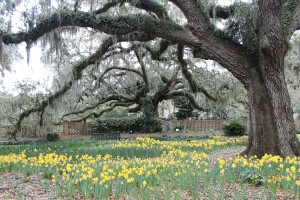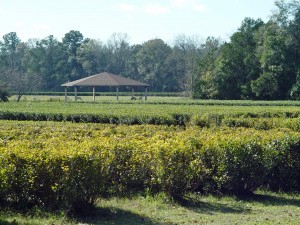Spring Is There… Maybe Here, Too, One of These Days
March 24th, 2015
I’m just back from a weeklong tour of glorious gardens of South Carolina, and I can assure you that spring really is on the way.
As our Lowee’s Group Tour bus of 38 winter-weary northern gardeners motored south on I-95, the grass got greener with each passing mile.
By the time we hit Charleston, S.C., spring had sprung.
Birds were singing, trees were budding, and even the azaleas were starting to open. Daytime highs were nestling around 70 degrees – very pleasant and a sign of what we should be getting in another 4 weeks or so.
Our intrepid group only got rained on once – the day we did a walking tour of Charleston’s historic downtown neighborhood followed by its garden tour, considered one of the country’s biggest and best.
Otherwise, the days were warm, and the nights just chilly. None of the snow or sub-freezing weather Harrisburg can’t seem to shake.
Two venues stood out as our group’s favorites.
One was the Charleston Tea Plantation, which is North America’s only tea-growing and tea-production farm.
People were fascinated to see acre after acre of Camellia sinensis plants, the tender broad-leaf evergreens whose sheared-off leaves are used to make black, green and oolong teas.
The day we were there, one of the farm’s long-legged cutting machines was shearing off last year’s growth to make way for this year’s first flush. The young first leaves apparently make the best tea.
When all of the cutting is done, fields full of camellias sport crew cuts – boxy, even and glistening in the sun.
We also saw such great, old southern gardens as Middleton Place, a formal garden that took 100 slaves 10 years to build in the mid-1700s, and Magnolia Plantation, a mostly shaded pleasure garden with Monet-like bridges and more camellias (27,000) than any other garden in the world.
But the stop that people enjoyed more than any other was Pearl Fryar’s 3-acre private yard in rural Bishopville, S.C.
Pearl is a 75-year-old retired factory worker who has built arguably the world’s most impressive topiary garden.
He’s carved most every plant in his yard – some 400 of them – into all kinds of abstract designs.
Some of them grow 20 to 30 feet high and require a lift to reach them to prune.
Pearl trims everything every 4 to 6 weeks all season long to keep the look dense and neat.
Some of the forms are spiraled or upright and pom-pom’ed. Others are more blocky or rolling, something along the line of a cloud formation. His signature piece is a 30-foot-tall Leyland cypress that looks like something out of a Dr. Seuss book.
It’s an incredible amount of work and motivation that stemmed from Pearl’s original goal to win the local garden club’s Yard of the Month award.
That was important to him because Pearl, who is African-American, had heard the stereotype about “not keeping up the yard” when he was house-hunting in white neighborhoods.
Not only did this super-human effort earn Pearl Yard of the Month honors, he’s become famous.
He’s been written about in national magazines, featured on national TV, and invited to speak at Harvard University. British horticulturists are planning to come and study his techniques.
In 2006, a documentary film called “A Man Named Pearl” was done about him and his topiary gardens.
Most recently, the yard was one of only two South Carolina locations featured in “The Gardener’s Garden” (Phaidon Press, 2014), a British book on 250 of the world’s greatest gardens. (The other featured garden was Middleton Place.)
The craziest thing is that Pearl has no training in gardening in general or topiary in particular. He just had a knack for, as he calls it, “cutting bushes,” and a work ethic that keeps him still hard at work at age 75.
As we found out, Pearl is also an earthy philosopher filled with tidbits of wisdom. He kept our group entertained for 90 solid minutes, professing from the throne of his chainsaw-adorned John Deere Gator.
The main question I wondered was what will become of this place when Pearl isn’t able to single-handedly take care of it anymore.
He told us that friends helped him form a non-profit called Pearl Fryar Topiary Garden Inc. The purpose is to raise money to someday buy the property and keep it going for future generations to see.
The organization accepts donations of any amount through Pearl’s website or by mail at Pearl Fryar Topiary Garden, P.O. Box 1111, Bishopville, S.C. 29010.
I could tell you more about what all we saw, but a better way is to look at pictures.
To get a flavor of this trip, check out the “Gardens of South Carolina” pictures I posted on my Photo Gallery page.











